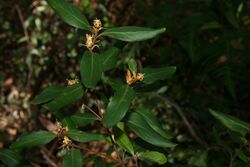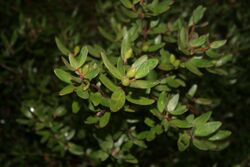Biology:Persoonia laurina
| Laurel geebung | |
|---|---|

| |
| Scientific classification | |
| Kingdom: | Plantae |
| Clade: | Tracheophytes |
| Clade: | Angiosperms |
| Clade: | Eudicots |
| Order: | Proteales |
| Family: | Proteaceae |
| Genus: | Persoonia |
| Species: | P. laurina
|
| Binomial name | |
| Persoonia laurina Pers.
| |
| Synonyms[1] | |
|
Persoonia ferruginea Sm. | |
Persoonia laurina, commonly known as the laurel-leaved or laurel geebung, is a shrub of the family Proteaceae native to central New South Wales in eastern Australia . Found in sclerophyll forest, it grows to a height of 2 metres (6 ft 7 in). The yellow flowers appear in late spring.
Taxonomy
Persoonia laurina was one of five species described by Christiaan Hendrik Persoon in his 1805 work Synopsis Plantarum,[2] from material collected by John White in 1793 and 1794.[3] The species name refers to a resemblance to Laurus "laurel".[4] James Edward Smith described this species as the rusty persoonia (Persoonia ferruginea) in his 1805 book Exotic Botany.[5] The horticulturist Joseph Knight used Smith's name in his controversial 1809 work On the cultivation of the plants belonging to the natural order of Proteeae,[6] as did Robert Brown in his 1810 work Prodromus Florae Novae Hollandiae et Insulae Van Diemen. Brown also recognised that the two names were the same species.[7]
In 1870, George Bentham published the first infrageneric arrangement of Persoonia in Volume 5 of his landmark Flora Australiensis. He divided the genus into three sections, placing P. ferruginea in P. sect. Amblyanthera.[8]
Within the genus, P. laurina is classified in the Laurina group, a group of three species from southeastern Australia that all have a lignotuber.[9]
Three subspecies are recognised.[10] First recorded as distinct in 1981, they were officially described as subspecies in 1991 by Lawrie Johnson and Peter Weston of the New South Wales Herbarium.[11]
Description
Persoonia laurina grows as a shrub with an upright or sprawling habit reaching anywhere from 0.2 to 2 metres (7 3⁄4 in to 6 ft 6 3⁄4 in) tall. New growth is covered with dense grey to rusty-brown hairs. Flowering takes place over November to January.[3] Seedlings have only two cotyledon leaves, unlike many members of the genus, which have more.[9]
Ecology
All three subspecies resprout after bushfire from a woody lignotuber. Subspecies laurina is estimated to have a lifespan of 50 to 100 years.[12]
Uses and cultivation
The bark was traditionally used by Aboriginal people to soak fishing lines and toughen them.[4] Drupes were eaten by indigenous people on the Beecroft Peninsula, though were not as highly regarded as those of P. lanceolata.[13]
P. laurina is an attractive plant with horticultural potential. Cultivating it would most likely require good water drainage, a position in sun or dappled shade and acidic soil. It is hardy to frosts.[14] However, it appears to be short-lived in cultivation, with plants at the Mount Annan Botanic Gardens surviving for a maximum of six years after planting out.[9] While difficult to propagate by seed,[4] it has been easier to propagate by cuttings of new growth.[9]
References
- ↑ "Persoonia laurina Pers.". Australian Plant Name Index (APNI), IBIS database. Centre for Plant Biodiversity Research, Australian Government. http://www.anbg.gov.au/cgi-bin/apni?taxon_id=60018.
- ↑ Persoon, Christiaan Hendrik (1805) (in la). Synopsis plantarum, seu enchiridium botanicum, complectens enumerationem systematicam specierum hucusque cognitarum. 1. Paris, France: Apud Carol. Frid. Cramerum. p. 118. https://www.biodiversitylibrary.org/page/234902. "foliis ovatis coriaceis, flor. racemosis tomentosis"
- ↑ 3.0 3.1 "Persoonia laurina Pers.". Flora of Australia Online. Department of the Environment and Heritage, Australian Government. http://www.anbg.gov.au/abrs/online-resources/flora/stddisplay.xsql?pnid=44571.
- ↑ 4.0 4.1 4.2 Wrigley, John; Fagg, Murray (1991). Banksias, Waratahs and Grevilleas. Sydney, New South Wales: Angus & Robertson. p. 488. ISBN 0-207-17277-3.
- ↑ Smith, James Edward (1805). Exotic Botany: consisting of coloured figures, and scientific descriptions, of such new, beautiful, or rare plants as are worthy of cultivation in the gardens of Britain; with remarks on their qualities, history, and requisite modes of treatment. 2. London, United Kingdom: R. Taylor & Co.. pp. 47.
- ↑ Knight, Joseph; Salisbury, Richard (1809). On the Cultivation of the Plants Belonging to the Natural Order of Proteeae. London, United Kingdom: W. Savage. p. 100. https://archive.org/details/oncultivationpl00kniggoog. "Persoonia."
- ↑ Brown, Robert (1810). Prodromus Florae Novae Hollandiae et Insulae Van Diemen. London, United Kingdom: Richard Taylor and Company. p. 373. https://www.biodiversitylibrary.org/page/36315650.
- ↑ Bentham, George (1870). "Persoonia". Flora Australiensis. 5. London, United Kingdom: L. Reeve & Co.. pp. 380–83.
- ↑ 9.0 9.1 9.2 9.3 Weston, Peter H. (2003). "Proteaceae subfamily Persoonioideae: Botany of the Geebungs, Snottygobbles and their Relatives". Australian Plants 22 (175): 62–78 [66]. ISSN 0005-0008.
- ↑ Weston, P.H.. "New South Wales Flora Online: Persoonia laurina". Royal Botanic Gardens & Domain Trust, Sydney, Australia. http://plantnet.rbgsyd.nsw.gov.au/cgi-bin/NSWfl.pl?page=nswfl&lvl=sp&name=Persoonia~laurina.
- ↑ Weston, Peter H.; Johnson, Lawrence Alexander Sydney (1991). "Taxonomic changes in Persoonia (Proteaceae) in New South Wales". Telopea 4 (2): 369–406 [281–83]. doi:10.7751/telopea19914929. http://plantnet.rbgsyd.nsw.gov.au/emuwebnswlive/objects/common/webmedia.php?irn=75767&reftable=ebibliography.
- ↑ Benson, Doug; McDougall, Lyn (2000). "Ecology of Sydney Plant Species Part 7b: Dicotyledon families Proteaceae to Rubiaceae". Cunninghamia 6 (4): 1017–1202 [1104–1105]. https://www.rbgsyd.nsw.gov.au/getmedia/eea3e2c5-4590-49ce-9114-4b7e8527d491/Volume-6(4)-2000-Cun6Ben1016-1202.pdf.aspx.
- ↑ Lampert, R. J.; Sanders, Frances (1973). "Plants and Men on the Beecroft Peninsula, New South Wales". The Australian Journal of Anthropology 9 (2): 96–108. doi:10.1111/j.1835-9310.1973.tb01380.x.
- ↑ Elliot, Rodger W.; Jones, David L.; Blake, Trevor (1997). Encyclopaedia of Australian Plants Suitable for Cultivation. 7: N–Po. Port Melbourne, Victoria: Lothian Press. p. 219. ISBN 0-85091-634-8.
Wikidata ☰ Q7170718 entry
 |


